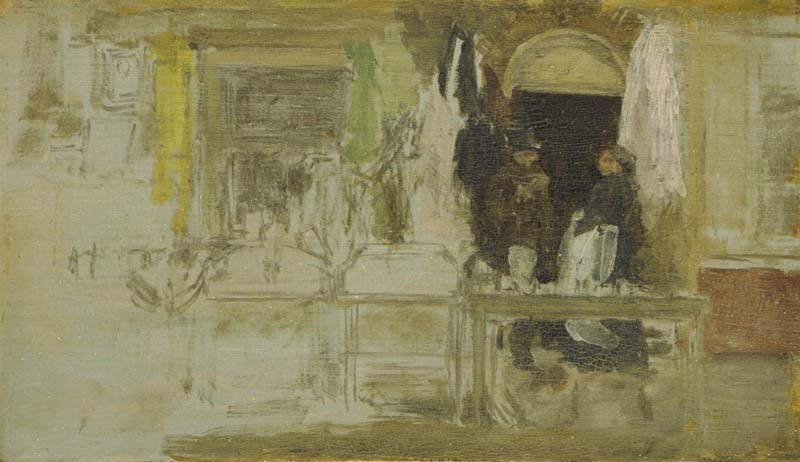Titles
There are several variations on the title, as follows:
- 'Jews clothes shop' (1901, Rosalind Birnie Philip). 1
- 'The Jews Shop Chelsea' (1901, Whistler). 2
- 'The Jews Shop, Chelsea' (1901/1935, anon.). 3
- 'Old Clothes Shop Houndsditch' (1936, Glasgow University). 4
- 'Old Clothes Shop, Houndsditch' (1980, YMSM). 5
Description
The shop front is drawn parallel to the edges of a horizontal panel. Two people – a man in a brown coat or cloak wearing a top hat, and, to right, a woman in black with a white apron – stand talking in front of an open door. A semi-circular brick arch above the door is filled in and painted white. Shapeless old clothes, black, brown and white, hang either side of the door. A window to left, and larger one to right of the door are pencilled in and tinted lightly with pale ochre and brown. At far left framed pictures (including a portrait) or posters are roughly indicated but not coloured. Across the entire frontage of the shop are tables with a mixture of goods, possibly including books.
Site
Houndsditch in East London was the centre of the second-hand clothing trade. Henry Mayhew described this area as it appeared in 1851:
'The trade in second-hand apparel is one of the most ancient of callings, and is known in almost every country, but anything like the Old Clothes exchange of the Jewish quarter of London, in the extent and order of its business, is unequalled in the world. ... until the last few years, the trade in old clothes used to be carried on entirely in the open air, [in] the Petticoat-lane district. ... adjoining Cutler-street. The chief traffic elsewhere was originally in Cutler-street, White-street, Carter-street, and in Harrow-alley – the districts of the celebrated Rag-fair.' 6
Whistler made many etchings of shops, including a series of etchings of Houndsditch in 1887. One etching, Cutler Street, Houndsditch [361], shows a second-hand clothes shop belonging to a Jewish shop-owner, Benjamin Abrahams, a dealer in government stores, one of a large community of 12,000 Jews who lived in the City, out of some 18,000 in the greater London area. They lived mostly within the area bounded by Spitalfields, Petticoat Lane, Leadenhall-Street, Aldgate, Whitechapel and Bishops-gate Street.
Subjects involving the second hand clothing trade, and based in the east End, include Petticoat Lane [299], Clothes-Exchange, Houndsditch. No. 1 [358], Clothes-Exchange, Houndsditch. No. 2 [359], Fleur-de-lys Passage [360], and After the Sale, Clothes Exchange, Houndsditch [357]. In St James's Place, at the heart of the Jewish enclave, the site of the Synagogue and small family-run shops, Whistler etched St James's Place, Houndsditch [255] and Nut Shop, St James's Place, Houndsditch [356].
He depicted other second-hand shops in both London and in Paris, including the painting Chelsea, Little Furniture Shop [YMSM 373], and the etchings Rag Shop, Milman's Row, Chelsea [329], Rag Shop, St Martin's Lane [328], Quai de Montebello [385], and Marchand de Meubles, Rue du Four [482].
Comments

Old Clothes Shop, Houndsditch,photograph by William Gray, inscr. 'The Jews Shop, Chelsea', GUL Whistler PH4/42
Whistler may have had several reasons for his interest in second hand and old clothes' shops, as a source for old silver, for instance, or for their picturesque and historical associations. His seeking out of subjects in the East-End of London, and in a predominantly Jewish area, may have arisen from his admiration for Rembrandt Harmens van Rijn (1617-1681). In the "Ten o'clock" Lecture of 1885 Whistler had extolled 'Rembrandt, when he saw picturesque grandeur and noble dignity in the Jews' quarter of Amsterdam – and lamented not that its inhabitants were not Greeks.' 7
Notes:
1: List, 16 February 1901, GUL Whistler BP II Ledger c, pp. 5-6.
2: Ibid.
3: Note on photograph, GUL Whistler PH4/42.
4: James McNeill Whistler, University of Glasgow, Glasgow, 1936 (cat. no. 1) as 'Old Clothes Shop Houndsditch'.
5: YMSM 1980 [more] (cat. no. 371).
6: Mayhew, Henry, London Labour and the London Poor, London, 1851.
7: [20 February 1885], GUW #06791; Whistler 1890 [more] , p. 136.
Last updated: 22nd October 2020 by Margaret







